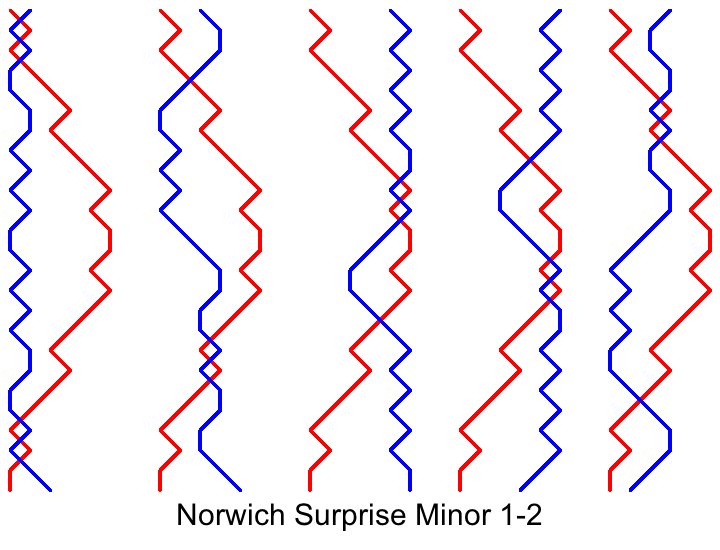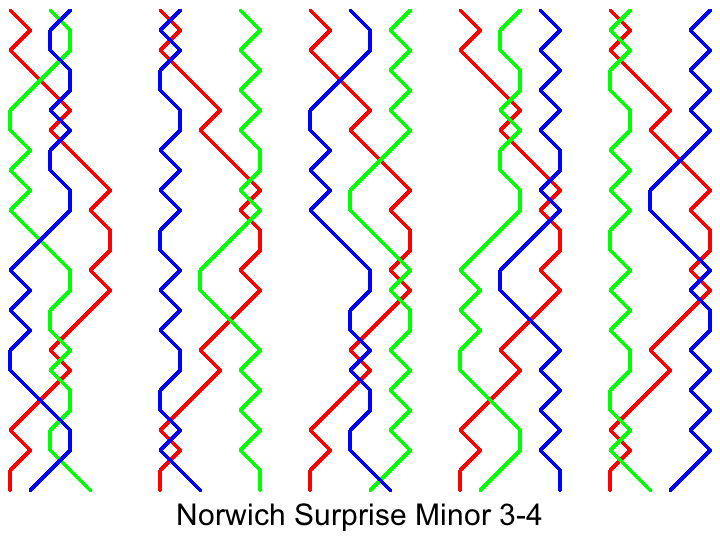There has been some discussion this week on the change-ringers email list about ways of thinking about methods for handbells, and in particular the role of place notation. I have taken this as a prompt to try out some thoughts about how to get started on ringing Surprise Minor, because the transition from simple rule-based methods such as Plain Bob, Little Bob and Kent to more complex surprise methods, naturally raises the question of which approach to take. Ultimately, however, I'm afraid that there isn't a magic formula. whichever way you think about it, you just have to try it and keep going until it starts to make sense.
Overview of Surprise Minor
The features that all Surprise Minor methods have in common are the following.
- The treble does treble bob hunting.
-
When the treble hunts between 2nds and 3rds place, a bell makes 4ths.
-
When the treble hunts between 4ths and 5ths place, a bell makes 3rds.
The second and third features are what distinguish surprise methods from treble bob or delight methods. One consequence of them is that while ringing surprise on handbells, it is common for one bell to dodge while the other bell hunts or makes a place.
There are thousands of possible Surprise Minor methods, but historically, ringers’ attention has often focused on a much smaller set, identified by a further list of desirable features (of course, it’s all a matter of taste). These features are:
-
Symmetry, so that the place notation in the second half of the lead is the reverse of that in the first half of the lead.
-
Plain course of 5 leads - in other words, every bell rings all the work of the method.
-
Plain Bob lead ends - that is, the changes at the treble's backstroke leads are the same as in Plain Bob, although not necessarily in the same order.
-
At most two consecutive blows in the same place.
-
5ths place is never made except at the half lead.
-
Never more than two places made simultaneously.
Applying these conditions brings the number of possible methods down to 41, which are often known as the “standard 41”. A consequence of these features is that in all 41 methods, the block of place notation 14x12x36 occurs as the treble moves from 2nds place through the 3-4 dodge to 5ths place. The treble dodges in 3-4 as 2nds place is made.
A useful way to think about surprise minor methods is to separate the work above and below the treble. Look at the grid of a method, with the treble’s path drawn in a different colour; the work is separated into two regions, above the treble (i.e. closer to the back of the change) and below the treble (i.e. closer to the front of the change). The work above the treble is also known as the backwork, and the work below the treble is also known as the frontwork. Within the standard 41, it turns out that there are only 4 different backworks (or 7 if you count the difference between 2nds and 6ths place at the lead end). Also several of the frontworks occur in more than one method.
Because all of the standard 41 contain the place notation 14x12x36 in the central part of the first half of the lead, the backwork is defined by the place notation when the treble is in 1-2, and the frontwork is defined by the place notation when the treble is in 5-6. Furthermore, the place notation at the lead end can be either 12 or 16. The effect of all this is that you can ring by thinking about the work above and below the treble, without needing to think about the situation in which one bell is above the treble and the other is below.
There are 4 possible backworks.
-
Norwich. The place notation when the treble is in 1-2 is x34x. There are two versions, with 12 or 16 at the lead end.
-
Cambridge. The place notation when the treble is in 1-2 is x36x. There are two versions, with 12 or 16 at the lead end.
-
London. The place notation when the treble is in 1-2 is 36x36. In the standard 41, this backwork is only rung with 12 at the lead end, otherwise there would be 4 consecutive blows in 6ths place across the lead end.
-
Carlisle. The place notation when the treble is in 1-2 is 34x36 in the first half of the lead; this is the only backwork in which the place notation is not symmetrical. There are two versions, with 12 or 16 at the lead end. Some people prefer to call this backwork Chester or Alnwick.
The number of frontworks is larger, because it’s possible for 2nds place to be made while the treble is in 5-6, whereas the standard 41 doesn’t include methods in which 5ths place is made while the treble is in 1-2. There are 6 possible right-place frontworks.
-
Cambridge. The place notation when the treble is in 5-6 is x14x56.
-
Ipswich. The place notation when the treble is in 5-6 is x14x16.
-
Annable’s London. The place notation when the treble is in 5-6 is x14x36. This frontwork and the previous two are all Cambridge with variations at the half lead.
-
Norwich. The place notation when the treble is in 5-6 is x34x16.
-
Bourne. The place notation when the treble is in 5-6 is x34x36. This is a half-lead variation of Norwich.
-
Westminster. The place notation when the treble is in 5-6 is x12x36.
In principle, any of these frontworks could be combined with any of the 7 backworks (two versions of each backwork, except London) to give a total of 42 methods. In practice, there are various ways in which some of these combinations might be undesirable:
-
The method might be false in the plain course.
-
The method might come round after fewer than 5 leads.
-
The method might not have Plain Bob lead ends.
Among the standard 41, there are 15 methods with these frontworks. If we restrict attention to the right-place backworks (Cambridge and Norwich) then there are ten methods: Cambridge, Ipswich, Norfolk, Primrose, Bourne, Hull, Norwich, Westminster, Annable’s London and Netherseale.
 Getting started: Norwich
Getting started: Norwich
In Norwich, the place notation is x34x when the treble is in 1-2, and again x34x when the treble is in 5-6. The half lead and lead end are both 16. This regularity helps to ring it by the position of the treble.
I will describe two ways of starting to ring Norwich; two ways of thinking about the method. In either case, there are some tips that apply to practising anything difficult.
-
Decide who is going to ring which pair, and stick to it until you reach a basic level of confidence.
-
Be prepared to practise the method one lead at a time. Ring each lead repeatedly until you get it right, then move on to the next lead. To practise the second and subsequent leads separately, start from the appropriate lead end instead of rounds.
-
Be prepared for the fact that if you have three people who are all learning it for the first time together, it might take a long time until you can ring it.
 Norwich is a right-place method, meaning that the place notation is X at every handstroke. Take advantage of this by “letting the handstrokes ring themselves”: the transition at every handstroke is just like ringing Plain Bob.
Norwich is a right-place method, meaning that the place notation is X at every handstroke. Take advantage of this by “letting the handstrokes ring themselves”: the transition at every handstroke is just like ringing Plain Bob.
Ringing by the blue lines
First you need to know the line, just as you would for ringing the method in the tower. You should also know the treble-passing positions and the positions of the dodges with the treble. Choose a pair: 1-2, 3-4 or 5-6, and study the diagram for each lead, noting how your bells work together and how the work fits in with the treble. Then try to ring it. If it doesn’t work, try the same lead again.
 Ringing by the structure
Ringing by the structure
In this approach, you need to follow the work of the treble as it dodges and hunts through each lead. In Norwich, like all the regular Surprise Minor methods, 2nds place is made as the treble dodges in 3-4, meaning that there is also a dodge in 5-6. Also, as the treble hunts between 2nd and 3rd place, and between 4th and 5th place, places are made immediately around it: 1st and 4th, or 3rd and 6th. In each case, as the places are made, a bell passes the treble, and the two bells furthest from the treble dodge together. When the treble dodges in 1-2 or 5-6, 3rd and 4th places are made, meaning that there is dodging in 1-2 and 5-6 in both cases. Finally, both the half lead and the lead end are plain hunting: the place notation is 16.
Try ringing each lead separately and then put it all together. It might be helpful for the ringer of 1-2 to announce what the treble is doing. You might find yourself thinking explicitly in terms of the place notation, but you should only think about the place notation at backstroke, because the handstroke is always X.
 Continuing: Cambridge
Continuing: Cambridge
The structure of Cambridge is also highly symmetrical. When the treble is in 1-2 the place notation is x36x, and when the treble is in 5-6 the place notation is x14x. In both cases, places are made nearest to and farthest from the treble. The half lead is 56 and the lead end is 12, which again are symmetrical.
Just as with Norwich, you can try ringing it by the blue lines or by the structure. The general instructions are exactly the same; the only difference is in the details of the lines and structure.
Branching out: variations of Cambridge
By changing the lead end and half lead, we can obtain 3 variations of Cambridge. Ringing 16 at the lead end produces Primrose. Ringing 16 at the half lead produces Ipswich. Doing both produces Norfolk. Together with Cambridge, these methods are known as the Cambridge Four (who are innocent, of course). With a sound knowledge of Cambridge, including where the half leads occur, it should be possible to ring all four; it’s a question of remembering to concentrate when the half lead or lead end is coming up. Norfolk seems to be the trickiest, because it has the variation at both points.
Cambridge with 36 at the half lead is called King Edward. It is not one of the standard 41, as it does not have Plain Bob lead ends. However, it has a 5-lead plain course. The half lead variation is essentially a half lead bob, so the plain course of King Edward is Cambridge with a bob at every half lead. King Edward with a 6ths place lead end is called Queen Mary. It is possible to splice these methods with other Cambridge variations to obtain extents without bobs.
There are two more right-place, Cambridge-above methods in the standard 41. They are Bourne and Hull. The place notation when the treble is in 5-6 is x34x, and the half lead is 36. Bourne has 2nds place at the lead end and Hull has 6ths place. Adding these methods to the Cambridge Four gives the Cambridge Six, for which there is a classic 720 of spliced: C-NIHCC-NPBI- three times.